
PSYCHODIAGNOSTIC CHIROLOGY - Hand reading by PDC chirologist Arnold Holtzman!

'Biometric Definitions of Personality' (BDP), formerly 'Psychodiagnostic Chirology' (PDC), is a singularly unique, state-of-the-art, discipline in psychological diagnosis.
NOV 23, 2008 (+ UPDATES: AUG 27, 2009 & MAY 17, 2013)
PsychoDiagnostic Chirology (PDC) - a full review!
Arnold Holtzman from Yehud, Israel presents PDC Hand Reading & 'The Illustrated Textbook of PsychoDiagnostic Chirology in Analysis and Therapy!'
Author: Martijn van Mensvoort
The Science of Handreading in Psychological Diagnosis. After the publication of his first book in 1983 'Applied Handreading', Arnold Holtzman (Ph.D. in Psychology) presented in 2004: 'The Illustrated Textbook of PsychoDiagnostic Chirology in Analysis and Therapy'. The book includes a combination of fascinating materials: a thorough theory about the human hand + beautiful illustrated photo-materials, which often present rather remarkable hand-features.
PDC is definitely a fascinating master-piece of modern hand reading, and Holtzman's work will likely be recognized by the experts in this field as one of the few milestones in the history of hand reading.
JUNE 27, 2014 UPDATE:
In august 2013 a schizophrenia study was presented titled: 'The Illustrated Textbook of PsychoDiagnostic Chirology in Analysis and Therapy', where the PROCEDURE describes: "A total of 13 parameters of the hand were examined. These parameters were selected from among those previously suggested as having a bearing on mental health issues including schizophrenia (Holtzman, 2004, 2012)".
Unfortunately, this research's 'procedure' appears biased because Holtman's major PDC indicator for schizophrenia is excessive length in the little finger - see: 'Applied Handreading' (2004), pages 121-123 - was not even mentioned inside this study!???
MAY 17, 2013 UPDATE:
In june 2012 Holtzman presented a 53 pages addendum for the book 'The Illustrated Textbook of PsychoDiagnostic Chirology in Analysis and Therapy'.
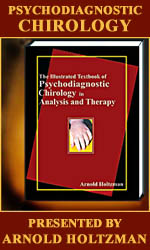
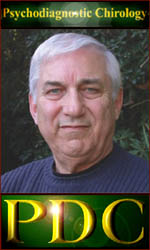

Ph.D. ARNOLD HOLTZMAN is the founder of the psychodiagnostic Handreading system 'PsychoDiagnostic Chirology' (PDC).
He is a graduate of Sir George Williams College (later Concordia University - Montreal, Canada) and Columbia Pacific University (California, USA).
His disertation study was entitled "The Morphology, Dermatoglyphics and General Constitution of the Human Hand as a Comprehensive Reference to Structures in Personality and Behavioral Dynamics."
He lives in Yehud (near Tel Aviv) in Israel.
A QUICK OVERVIEW OF THIS REVIEW IN 5 STEPS:
First, this review will describe the postion of PDC in the field of modern hand reading.
Second, the introduction of 'The PDC hand model' will describe the theoretic framework behind PDC.
Third, the importance of the thumb will be explained.
Fourth, a short description of the PDC laboratory testing will be presented.
And finally, the position of PDC in academic science and therapy today, will be discussed.
• 1 - The position of PDC in modern science & hand reading
• 2 - The PDC hand model
• 3 - The thumb is an important aspect in PDC
• 4 - The PDC laboratory testing
• 5 - The position of 'PsychoDiagnostic Chirology' today
• 1 - THE POSITION OF PDC IN MODERN SCIENCE & HAND READING
PDC is described by Holtzman in his second book 'The illustrated Textbook of PsychoDiagnostic Chirology in Analysis and Therapy' as: "From its somewhat esoteric origins in the medical-genetic science of dermatoglyphics, PsychoDiagnostic Chirology (PDC) has evolved to become one of the most powerful and dramatic tools available to professional therapists in the behavioral sciences today."
Holtzman has positioned PDC in line with the theoretical conceptualizations and clinical orientation described by psychiatrist Sigmund Freud (1856-1939), pediatrician Donald Winnicott (1896-1971), psychologist Abraham Maslow (1908-1970), and psychiatrist Heinz Kohut (1913-1981).
PsychoDiagnostic Chirology includes some concepts handed over by important figures in the 20th century psychology.




From left to right: Sigmund Freud, Donald Winnicott, Abraham Maslow & Heinz Kohut.
In the preface of his new book Holtzman describes PDC as related to the science of dermatoglyphics:
"We may visualize it as a form of handreading in psychological diagnosis. Its origins are in the dermal patterns of the palmar surface of the human hand (and foot) constructions which have a bearing on a wide range of organic and largely inherited disorders. Wholly unrelated to palmistry, or any similarly esoteric mode of prediction, dermatoglyphics has been accepted and applied in cytogenetic laboratories in many major hospitals around the world as a standard diagnostic procedure for more than half a century."
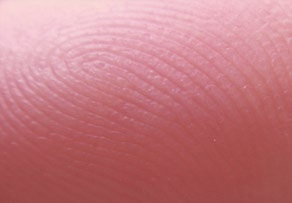
"PDC is, fudamentally, a language wherein the abstract symbols made manifest in the dermatoglyphics, morphology and constituation of the hand give representation to the widest range of psychical constructs."
However, PDC goes far beyond the analysis of the fingerprints and palmar dermatoglyphics. Actually, in both of his books Holtzman focusses much more on constructions in the hand morphology (including: finger length) & the palmar creases (including: the simian line). The features of the dermatolgyphics are only an accessory aspect of PDC handreading.
• 2 - THE PDC HAND MODEL
In the handreading system PsychoDiagnostic Chirology, Holtzman has introduced a hand model: the 'PDC hand model' [NOTICE: term 'PDC hand model' is introduced here by the author, and appears to have not been used by Holtzman].
The 'PDC hand model' includes the 2 polar dimensions: 'CONSCIOUS - SUBCONSCIOUS' and 'MIND - BODY', which were already included in the theoretical conceptualizations described by Freud.
Some quick definitions of the 2 polar dimensions in relation to the hand, as described in Holtzman's 2th book:
• "MIND defines the global influence of cerebral references" [the fingers].
• "BODY defines the global influence of biological references" [the palm].
• CONSCIOUS is related to the condition of "knowing things" [the thumb half, radial side].
• "The SUBCONSCIOUS is the dominion of all the references that are beyond conscious organization" [the percussion half; ulnar side].
Combining the 2 polar dimensions creates the 4 zones of the 'PDC hand model' [including quite a lot of vocabulary derived from Freud's psychoanalysis]:
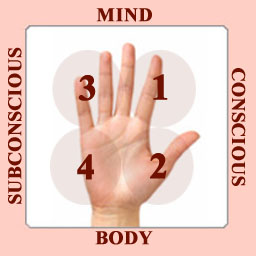
• Zone 1 - CONSCIOUSNESS in the system of MIND:
In PDC this zone of the hand is related to e.g.: identity alignments, intensity of awareness, individuals public image.
As a rule in PDC the index finger (which is is linked to the so-called 'persona' [Freud]) and middle finger (linked to the 'self' [Freud]) are studied to understand this 1st dimension in personality.
• Zone 2 - CONSCIOUSNESS in the system of BODY:
In PDC this zone of the hand is related to e.g.: conditioned drives (including the so-called: 'live drive' [Freud] + 'sex drive' [Freud]) & attitude patterns, somatic initiatives.
As a rule in PDC the thenar eminence (linked to the so-called 'Ego energies' [Freud]) - in palmistry: the mount of Venus + the mount of Mars - is studied to understand this 2th dimension in personality.
• Zone 3 - SUBCONSCIOUSNESS in the system of MIND:
In PDC this zone of the hand is related to e.g.: conception of personal worth.
As a rule in PDC the little finger (which is linked to the 'inner image of self' [Freud]) and ring finger (linked to the 'role identity' [Freud]) are studied to understand this 3th dimension in personality.
• Zone 4 - SUBCONSCIOUSNESS in the system of BODY:
In PDC this zone of the hand is related to e.g.: the primary instincts (including the so-called: 'life instincts', 'sex instincts', and 'death instincts' [Freud]).
As a rule in PDC the hypothenar eminence (mount of Moon) is studied to understand this 4th dimension in personality.

• 3 - THE THUMB IS AN IMPORTANT ASPECT IN PDC
Another important aspect in PDC is represented by the thumb, which is related by Holtzman to the "gravitation to autonomy and independence". The upper part of the thumb (the nail phalange) is linked to the 'impulse to will' [Holtzman introduced this new concept in his second book!], and the lower phalange (between the upper phalange and the thenar eminence) is linked to 'counterwill' [Freud].
In this perspective Holtzman makes in his latest work some very interesting comments on the thumb growth from childhood to adulthood (page 93):
"... The reality of the infant has it totally dependent upon thos who assume responsibility for its welfare. This is reflected in the undeveloped tip phalange of the thumb (relative to the phalange beneath it) which shows no capacity for willfullness."
NOTICE: Not reported in Holtzman's work, the author can confirm that Holtzman's description indeed refers to the 'normal' hand development. More specific: the 'normal' length development of the various hand bones!
For, the results of various research programs (Behrents et.al., 1987) have pointed out that even in adults the hand is likely to show length INCREASES in the distal phalanges (the nail phalanges, including the nail phalange of the thumb), and length DECREASES in the metacarpal bones (in the palm).
The intermediate phalanges appear to show INTERMEDIATE length developments, which implicates for the proximal phalanges: no length changes; and for the middle phalanges: the length INCREASES are less pronounced that the distal phalanges! By the way, one should notice here that these length variations in adults were noticed over a time-span of at least 3 deades (30+ years).
• 4 - THE PDC LABORATORY TESTING (conducted in: 1987-1988)
• 5 - THE POSITION OF 'PSYCHODIAGNOSTIC CHIROLOGY' TODAY! (in 2008)
Holtzman writes in the preface of his book about the laboratory testing of PDC (page viii):
"It is now clear that PDC has a firm foundation in scientific principles and the support of considerable scientific evidence.
To begin with, as a diagnostic discipline it lends itself exceedingly well to laboratory testing.
Pilot studies conducted at Bar-Ilan University and the Nes Ziona Governement Psychiatric Hospital (both in Israel) have established high validity factors and a reliability factor in excess of 80%."
Holtzman presents on his website more details about the PDC laboratory testing. The online-report appears to include at least 3 important findings:
1 - In a sample of 6 patients suffering mental disorders, including 1 'test-patient' (this person, who was completely without pathological circumstances, was planted among the patients as a 'test-patient'),
Holtzman successfully identified the 'test-patient'.
2 - The "inter-observer reliability" among the observations of eight of Holtzman's PDC students (on 12 patients) was established at 80%.
3 - The "validity" of PDC was tested by a comparison between (a) Holtzman's observations on the hand-photos of 21 subjects - including: patients AND non-patients (as a control group!) - and (b) the evaluations made by Dr. Natan Karni.
The overall result is not described, however from the details one can conclude that in 4.7% (= 2+0 of the 42 cases) of the examinations the "validity" between the evaluations presented by Holtzman and Dr. Natan Karni were described as: 'total correlation';
and in 9.5% (= 3+1 of the 42 cases) of the examinations the "validity" between the evaluations presented by Holtzman and Dr. Natan Karni were described as: 'no correlation'.
The result regarding the "validity" could also be described as follows:
in 35,7% (= 2+1+2+0+4+6 of the 42 cases) of the examinations the validity was 'confirmed'; in 21,4% (= 5+4 of the 42 cases) of the examinations the validity was 'neutral'; and in 42,9% (= 6+2+3+4+2+1 of the 42 cases) of the examinations the validity was 'denied'.
NOTICE: In the years 2000 & 2001 the author has presented 2 likewise pilot-studies (read further: program 1 & program 2), in coöperation with staff & students of the largest Dutch hand analysis school Academie Antropodynamica.
By the way, these pilot-studies were focussed a sample of Dutch students who performed 'extraordinary' on a Dutch personality assessment questionnaire (NEO PI-R).
The "inter-observer reliability" results reported in these studies were in respective: 65% and 66%; and the "success score" results were in respective: 58% and 62%.
So far in the history of hand reading (including 2008), no other likewise research programs have been presented.
More specific: no other research program have been conducted on any other hand reading system in the world, including a likewise "validity"-testing.
B.t.w. a "validity"-testing should by definition include a comparison with an 'established source' - this can be for example: the observations of health care professional (psychiatrist), a personality questionnaire, etc.
An illustration of the fact that uptill today, the three pilot-studies mentioned in this article (including Holtzman's 'PDC laboratory testing'), still bear a very unique character!!!
Over the past decade Holtzman has been able to attract students and orders from about 90 countries.
Repeated supervision requests on PDC have been provided to health care professionals from about 10-12 countries.
Also has PDC been adopted by a considerable number of specialists in the professional behavioral sciences from various countries.
Today the major PDC institutes in the world are found in Israel and Hong Kong.
In Israel the science of PDC is promoted by 'The Israel Association for PsychoDiagnostic Chirology' (IAPDC).
And since 2007 the science of PDC has been promoted in cooperation with the New Horizons Development Centre in Kowloon, Hong Kong.
January 18, 2008 was marked for the establishment of 'The Hong Kong Association for PsychoDiagnostic Chirology'.

Seated at the first row from the left: Fritz Pang (founder and director of New Horizons Development Centre), Irene Tsang
(Honorary Chairman of 'The Hong Kong Association for PsychoDiagnostic Chirology'), Arnold Holtzman (PDC founder).
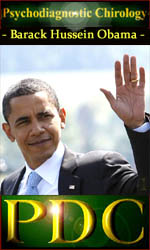
Arnold Holtzman presents:
PDC HAND ANALYSIS OF BARACK HUSSEIN OBAMA!!
Master chirologist Arnold Holtzman describes Obama's personality + some hidden syndromes from his hands.







More 'hands of famous people' combined with PDC Hand Reading by Arnold Holtzman are found a his website.
You can order Arnold Holtzman's book
via the ORDER PAGE on his website.
Take a look at some other pages of Arnold Holtzman's book via the picture below:
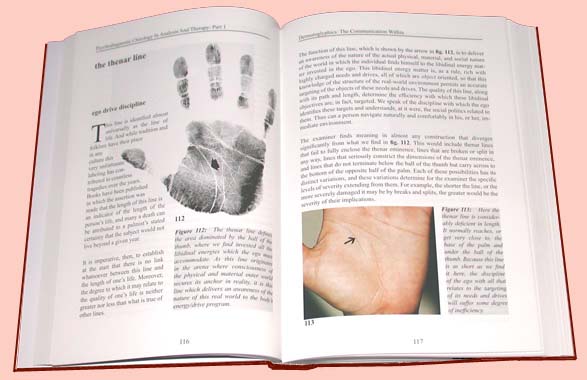
"There is one rule in handreading in psychological diagnosis which overrides all others."
"This one rule holds that everything modifies everything else.
Everything has an influence on everything else,
and everything is influenced by everything else."
- Arnold Holtzman in 'PsychoDiagnostic Chirology' (page 2) -
More hand analysis research:
Hands related to the BIG FIVE dimension Neuroticism
Handedness, Finger length & Palm shape asymmetry
The Hands of left-handed twins
Chirology, Hand Reading & Hand Analysis
HAND DIAGNOSTICS - PART 1: The simian line, a notorious hand crease!
HAND DIAGNOSTICS - PART 2: The Sydney line, an underestimated hand crease!
HAND DIAGNOSTICS - PART 3: The 5th finger, never underestimate your pinky!
HAND DIAGNOSTICS - PART 4: The nail tutur, find the cause of your nail disorder in 4 steps!
South-Africa chirologist Jennifer Hirsch presents: 'God Given Glyphs'
The work of chirologist Arnold Holtzman
PsychoDiagnostic Chirology